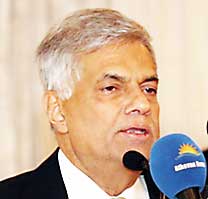Sunday Dec 15, 2024
Sunday Dec 15, 2024
Thursday, 2 June 2016 00:00 - - {{hitsCtrl.values.hits}}
 By Devin Jayasundera
By Devin Jayasundera
As Sri Lanka outlines its plans of becoming the next science hub in the Indian Ocean, Prime Minister Ranil Wickremesinghe on Tuesday stressed the need to increase science teachers at tertiary level as the first step.
Speaking at a symposium organised by the Science Council of Asia, the Prime Minister emphasised on the necessity to strengthen the scientific educational infrastructure in the country.
“To begin with, we don’t have sufficient science teachers in the schools. As a result the number of students in the science faculty is lower.
This is a chicken and egg situation. To get out of this trap the Government will put a massive effort to train a large number of science teachers.”
Highlighting the lack of research and development efforts in science and technology, the Prime Minister mentioned that research institutions which were constrained with fiscal austerity measures should changes their ways and adapt to be relevant to current trends.
“Science and technology is a vital aspect in the economic growth of the country,” said the Prime Minister. “Our goal is to double our GDP certainly by 2025 and become a high income economy by the third decade of this century. Technology and innovation is an essential requirement for development.”
In realising these goals, the Government intends to sign cooperative agreements with giants of science and technology in Asia such as Japan, China, South Korea and India.
Science and Research Minister Susil Premajayantha speaking at the event said: “Out of the 25,000 students enrolled in the Science faculty, 15% of students pursue their undergraduate education in science (excluding medical and engineering).”
He added that the Government had already taken steps to enhance technical education in the country by partnering with a leading Japanese university which will commence operations this year.
The Science Council of Asia is the premier scientific body in promoting regional cooperation in science research among Asian countries. Leading scientists from Asia were invited to present and discuss their research at the conference.